Celebrating the Birthday of Joaquin Sorolla y Bastida
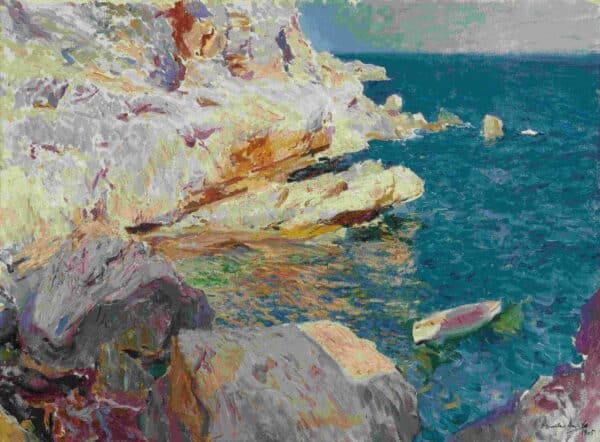
Joaquin Sorolla, Rocks at Javea, 1905, Oil on Canvas
Today we are celebrating the birthday of the great Spanish artist Joaquin Sorolla y Bastida. Born on 27th February 1863, Sorolla was a painter whose ability to capture sunlight is arguably unparalleled. In honour of his birthday, we’d like to shed some light ourselves onto the Spanish master’s remarkable life and career.
A Brief Biography of Joaquin Sorolla
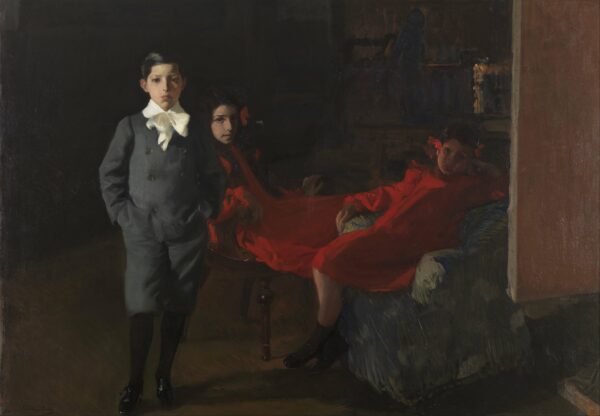
Joaquin Sorolla, My Children, 1904, Oil on Canvas
Joaquin Sorolla was born in Valencia and faced tragedy within the first two years of his life. Having been orphaned in 1865, Sorolla and his sister were taken in and raised by their aunt. Sorolla’s artistic talents were recognised at an early age and were nurtured and encouraged. His education began with a place at Valencia’s School of Artisans and he achieved success and notoriety at an impressive pace.
Inspired in his youth by his nation’s previous masters, such as Francisco de Goya and Diego Velasquez, Sorolla’s art bridged a gap between the darkness and intensities of these older artists and the light-focused modernity of the Impressionists. He met and befriended the likes of Sargent, Zorn and Boldini in the time he spent living and working in Paris, their styles influencing his and vice versa.
Though he adored his home city, Sorolla married his beloved wife Clotilde and lived with her and his three children in a beautiful house in Madrid (which was bequeathed to the state by Clotilde after her husband’s death). In Sorolla’s piece Mi Hijos (My Children), for example, we can see a clear inspiration taken from Valesquez’s hand. The dark palette and direct gazes emulating a captivating likeness to Las Meninas.
Sorolla was a painter of many subjects, including striking portraiture, landscape and much in between. Often painting en plein air like a true Impressionist. As Sorolla’s career progressed he gained international acclaim, exhibiting with great success across Europe and the Americas. He received important commissions (as we’ll go on to explore) and got to live in a world where his work was revered by many.
A Sea of Blue and White
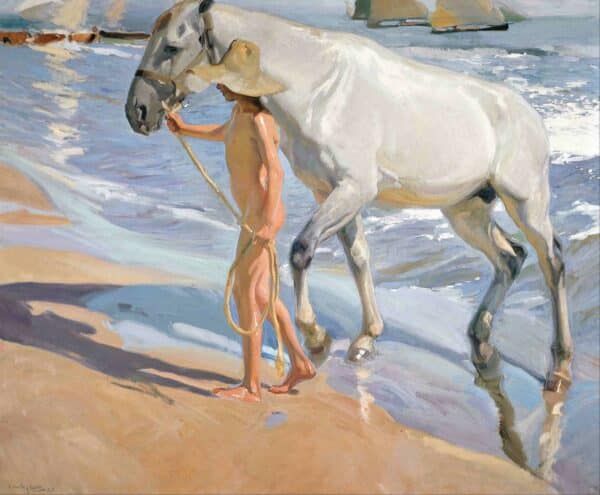
Joaquin Sorolla,The Horse’s Bath, 1909, Oil on Canvas
Joaquin Sorolla’s oeuvre was immense and thematically eclectic. However, it is undeniable that some of his most famous and visually stunning paintings are those set on the dazzling beaches on his childhood coastline of Valencia. Within these great works, Sorolla not only captures sunlight like no other but demonstrates his finesse and mastery of colour. Especially through his use of blue and white.
In his 1909 painting The Horse’s Bath, Sorolla presents the viewer with an image of true harmony between man and animal. A nude youth leads his gleaming grey horse out of the gently lapping waves. As the sail boats glide by in the background and the sun dances on the water, Sorolla’s use of blue and white captures the refreshing nature of the ocean and the sparkling light which dances upon it.
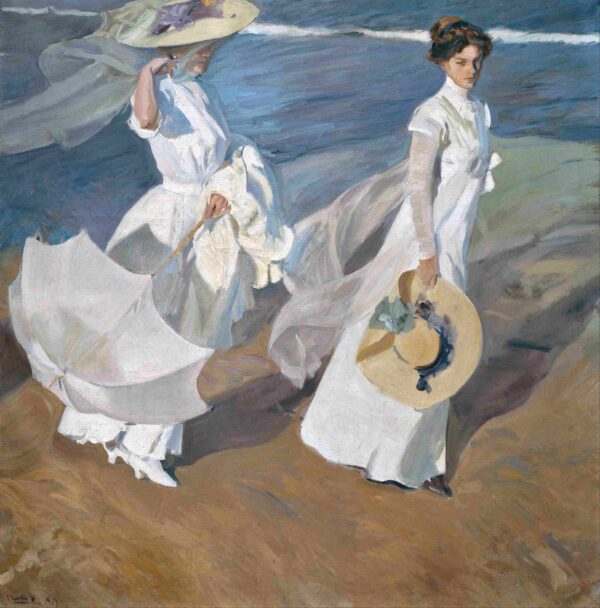
Joaquin Sorolla, Strolling Along the Seashore, 1909, Oil on Canvas
Another iconic piece of this subject matter is a work he also completed in 1909; Strolling Along the Seashore. In this painting we see Sorolla’s wife Clotilde and eldest daughter wearing dresses illuminated by his use of white paint, which blow in the sea breeze. The loose brushstrokes create movement in the sand and the many hues of blue and purple blends the sea into the shore.
Vision of Spain

Joaquin Sorolla, Vision of Spain – Ayamonte: The Tuna Catch, 1919, Oil on Canvas
Whilst his atmospheric portraits and vibrant depictions of nature propelled Sorolla’s work into the global art sphere, one of his greatest legacies is the monumental painting cycle entitled Vision of Spain. Commissioned in 1911 by Archer Milton Huntington, scholar and founder of the Hispanic Society of America in New York, Huntington had seen and admired Sorolla’s work that focused on social realism.
He asked Sorolla to create a collection of works that captured the customs, costumes and traditions of the different regions in Spain, which were to hang in the Society’s library. Considered to be a ‘map of regional identity’, the 14 enormous panels are captivating and epitomise the exemplary skill of the artist as well as his fascination with his country and its varying culture.
A particularly striking image in this impressive carousel represents the region of Andalusia and is known as Ayamonte: The Tuna Catch. In this piece Sorolla returns to the ocean to celebrate the fishermen of the south of Spain. The painting demonstrates, yet again, Sorolla’s technical virtuosity as the blue of the Tuna parallels the gleaming blue of the sea behind the workers unloading their catch.
In a cyclical type of tragedy, it was whilst painting a portrait that Joaquin Sorolla suffered a stroke, causing him to fall down his garden steps. Sorolla died a few years later in 1923 and, after working on Vision of Spain for ten years, sadly never got to see the inauguration of his master work.
The Master Of Light
After his death, Sorolla’s notoriety outside of Spain steadily decreased. In recent years, however, institutions such as the National Gallery in London have made great efforts to bring his talents back into focus. In 2017, Spain’s unsung artistic hero got his first major exhibition in the Uk since 1908, in which he was once again heralded the Master of Light.
For obvious reasons, here at the Blue & White Company we greatly admire Sorolla’s work and felt compelled to join the revival. If you, like Sorolla, are a lover of the sea you might be interested in our lovely Seabreeze Tablecloth . A refreshing design of blue and white which we think, brings the joys of the ocean into your home.
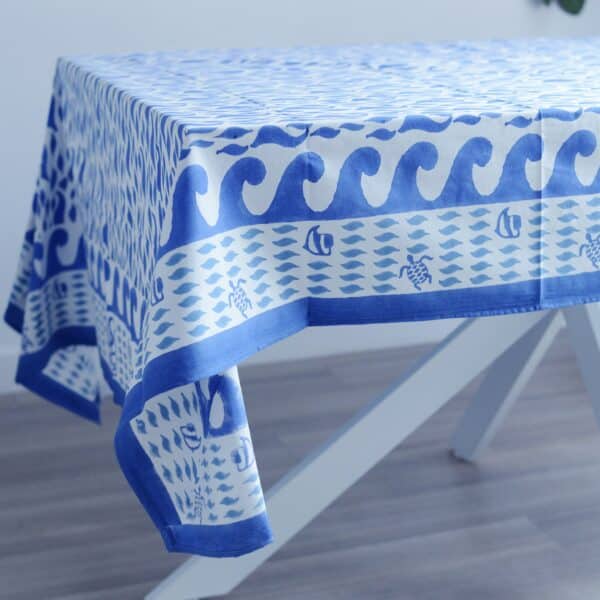
Blue & White Company, Seabreeze Tablecloth
“Sorolla – the painter of vibrating sunshine without equal” James Gibbons Huneker, American Art Critic